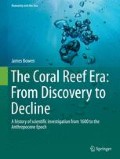Abstract
The big question that remained unanswered in coral science was the nature of thecoral polyp and its place in reef building. Huxley’s development of a new taxonomyof invertebrates provided a base, which along with advances in embryology, and inbiology the growing understanding of chlorophyll and photosynthesis in plants,provided necessary clues. Brandt and Keeble were finally able to establish thesymbiotic relationship between polyps and algae, and to resolve the riddle. At thesame time, the newly introduced concept of ecology, the community of relationshipswithin nature, helped interpret reefs in a new light, as a marine environment, and setthe scene for the next century of coral reef science.
Access this chapter
Tax calculation will be finalised at checkout
Purchases are for personal use only
Notes
- 1.
Huxley 1864, pp. 23–24 (“mesenteries”: Gk mesos, “mid” + enteron, “intestine”).
- 2.
Molluscoida: “mollusc-like”; Annuloida: “segmented, worm-like”.
- 3.
Fitton, in King 1827, II, pp. 592–593.
- 4.
Nereis, daughter of the sea god Nereus; granddaughter of Okeanos.
- 5.
Harvey 1846–1851, I, fasc. 13, Plate 73.
- 6.
Halimeda, a calcareous green alga (Gk halimures, “of the sea”), Phylum Chlorophyta; Nullipores (Lat. “no pores”) is an overall term for encrusting coralline algae of the family Corallinaceae in the same phylum.
- 7.
Veron 1995: 49 f.
- 8.
Semper 1868, p. 228 (reproduced in translation by Nyhart 1995, p. 179).
- 9.
Semper (1868, pp. 71–74 of the 1880 translation).
- 10.
Semper (1868, p. 76 of the 1880 translation).
- 11.
Euglena viridis is today classified as Phylum Euglenophyta in the Kingdom Protista. Isomeric: same atomic elements arranged differently.
- 12.
The assistance of diving companion Niels Feldman of Darmstadt, Germany, with this section, and especially with the translation of the Brandt (1881) article, is gratefully acknowledged.
- 13.
Zooxanthellos is pronounced correctly as “Zoh-oh-zan-thell-oss”, and the plural, zooxanthellae, as “zoh-oh-zan-thell-eye”. The suffix “xanthellos” is a Greek diminutive of “yellowish-green”.
- 14.
Considerable interest in algal densities was generated when high levels of solar irradiance were linked with zooxanthellae loss during episodes of coral bleaching that became prominent in the 1980s and thereafter (McCowan et al. 2011, p. 31 report densities between 3.85 × 106 and 2.77 × 106 cm2; see Chapter 13).
- 15.
Barnes’ original term was the simpler and etymologically debated “photosyntax” (Gk syntaxis, “systematic arrangement”. The description is from Gest (2002, pp. 7–10).
Author information
Authors and Affiliations
Rights and permissions
Copyright information
© 2015 Springer Science+Business Media Dordrecht
About this chapter
Cite this chapter
Bowen, J. (2015). Reef Construction and Symbionts. In: The Coral Reef Era: From Discovery to Decline. Humanity and the Sea. Springer, Cham. https://doi.org/10.1007/978-3-319-07479-5_8
Download citation
DOI: https://doi.org/10.1007/978-3-319-07479-5_8
Published:
Publisher Name: Springer, Cham
Print ISBN: 978-3-319-07478-8
Online ISBN: 978-3-319-07479-5
eBook Packages: Earth and Environmental ScienceEarth and Environmental Science (R0)

